AMD Announces Radeon R9 Nano; mini-ITX Card Shipping September 10th
by Ryan Smith on August 27, 2015 8:00 AM EST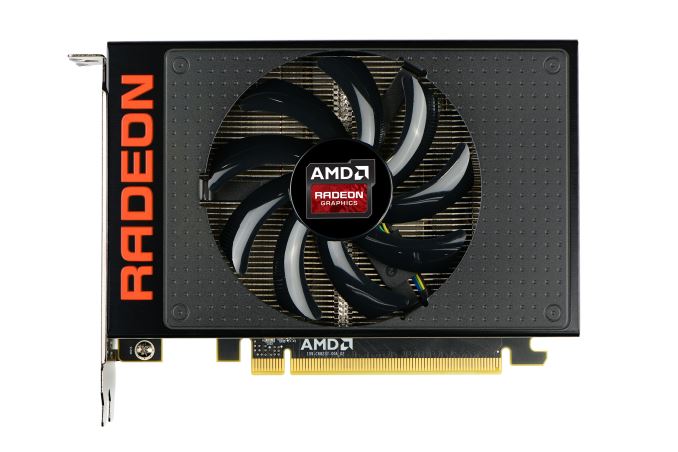
Back in June at AMD’s R9 Fury X/Fiji GPU launch event, the company unveiled that there would be four products based on Fiji. Fury X and Fury – which have since launched – and then two additional products, the R9 Nano and a yet-to-be-named dual-GPU card. Uncharacteristicly for AMD, the R9 Nano was unveiled some time before it would ship in order to demonstrate some of the size benefits of the Fiji GPU and its HBM, with the card initially receiving a tentative launch date of “summer”.
Now with August coming to a close, AMD is formally announcing the R9 Nano ahead of its full launch next month. The card, which will be AMD’s take on a premium, specialty product for the mini-ITX market, will be hitting retailer shelves on September 10th for $649.
| AMD GPU Specification Comparison | ||||||
| AMD Radeon R9 Fury X | AMD Radeon R9 Fury | AMD Radeon R9 Nano | AMD Radeon R9 390X | |||
| Stream Processors | 4096 | 3584 | 4096 | 2816 | ||
| Texture Units | 256 | 224 | 256 | 176 | ||
| ROPs | 64 | 64 | 64 | 64 | ||
| Boost Clock | 1050MHz | 1000MHz | 1000MHz | 1050MHz | ||
| Memory Clock | 1Gbps HBM | 1Gbps HBM | 1Gbps HBM | 6Gbps GDDR5 | ||
| Memory Bus Width | 4096-bit | 4096-bit | 4096-bit | 512-bit | ||
| VRAM | 4GB | 4GB | 4GB | 8GB | ||
| FP64 | 1/16 | 1/16 | 1/16 | 1/8 | ||
| TrueAudio | Y | Y | Y | Y | ||
| Transistor Count | 8.9B | 8.9B | 8.9B | 6.2B | ||
| Typical Board Power | 275W | 275W | 175W | 275W | ||
| Manufacturing Process | TSMC 28nm | TSMC 28nm | TSMC 28nm | TSMC 28nm | ||
| Architecture | GCN 1.2 | GCN 1.2 | GCN 1.2 | GCN 1.1 | ||
| GPU | Fiji | Fiji | Fiji | Hawaii | ||
| Launch Date | 06/24/15 | 07/14/15 | 09/10/15 | 06/18/15 | ||
| Launch Price | $649 | $549 | $649 | $429 | ||
Diving right into the design and specs, the R9 Nano is designed to be a showcase piece for the space savings that HBM technology offers. With Fiji’s 4GB of VRAM confined to a quartet of small, stacked packages near the GPU die, the overall space occupied by the complete GPU package is quite small, just over 1000mm2. Similar to what we saw with the R9 Fury X, the lack of large GDDR5 memory chips allows AMD to build a smaller board overall, and R9 Nano is to be the logical extension of what R9 Fury X started, bringing Fiji down to a mini-ITX sized video card.
In order to achieve this AMD has turned to a combination of chip binning and power reductions to make a Fiji card viable as the desired size. The Fiji GPUs going into the R9 Nano will be AMD’s best Fiji chips (from a power standpoint), which are fully enabled Fiji chips that have been binned specifically for their low power usage. Going hand in hand with that, AMD has designed the supporting power delivery circuitry for the R9 Nano for just 175W, allowing the company to further cut down on the amount of space required for the card.
The end result is that from a specification standpoint the R9 Nano should be an impressive, tiny terror. Since it’s a full Fiji GPU the R9 Nano doesn’t take an immediate hit to its performance relative to the R9 Fury X, featuring the same 4096 stream processors and 4096-bit ultra-wide HBM memory bus. The only real differences between R9 Fury X and R9 Nano are the clockspeed and the TDP/power targets. The R9 Nano will ship with a boost clock of 1000MHz versus R9 Fury X’s 1050MHz boost clock, and the TDP is 175W versus 275W.
The resulting performance difference in turn will come down to power limits. While R9 Nano has a 1000MHz boost clock, even with AMD’s binning 175W is a relatively harsh power limit for such a powerful GPU, and consequently the R9 Fury X the R9 Nano is expected to power throttle under normal circumstances. AMD tells us that the typical gaming clock will be around the 900MHz range, with the precise value depending on the power requirements of the workload being run. As to why AMD is shipping the card at 1000MHz even when they don’t expect it to be able to sustain the clockspeed under most games, AMD tells us that the higher boost clock essentially ensures that the R9 Nano is only ever power limited, and isn’t unnecessarily held back in light workloads where it could support higher clockspeeds.
Moving on, the physical board itself measures just 6” long, allowing the complete card to fit within the full width of a mini-ITX motherboard. Power delivery is handled by a single 8-pin PCIe power socket, which is becoming increasingly common, replacing the 2x 6-pin setup for 150W-225W cards. In order to get the length of the board down AMD has moved some of the power delivery circuitry to the back of the card; the front of the card still contains the inductors and heat-sensitive MOSFETs, while a number of capacitors are on the rear of the card (and is why you won’t find a backplate).
Responsibility for cooling the card falls to the R9 Nano’s new open air cooler, an aggressive design that has been specifically tailored to allow the card to effectively dissipate 175W of heat in such a small space. The overall design is best described as a combination open-air and half-blower hybrid; the design is technically open-air, however with only a single fan AMD has been able to align the heatsink fins horizontally and then place the fan in the center of the heatsink. The end result is that roughly half of the heat produced by the card is vented outside of the case, similar to a full blower, while the other half of the heat is vented back into the case. This reduces (though doesn’t eliminate) the amount of hot air being recycled by the card.
Drilling down, we find that the R9 Nano’s heatsink assembly is actually composed of two separate pieces. The primary heatsink is a combination vapor chamber and heatpipe design. A copper vapor chamber serves to draw heat away from the Fiji GPU and HBM stacks, and then heatpipes are used to better distribute heat to the rest of the heatsink. Meanwhile a small secondary heatsink with its own heatpipe is mounted towards the rear of the card and is solely responsible for cooling the MOSFETs.
The use of a vapor chamber in the R9 Nano makes a lot of sense given the fact that vapor chambers are traditionally the most efficient heatsink base type, however the R9 Nano is also unique in that we typically don’t see vapor chambers and heatpipes used together. Other designs such as the high-end GeForce series use a single large vapor chamber across the entire heatsink base, so among reference cards at least the R9 Nano stands alone in this respect, and it will be interesting to see what cooling performance is like.
That said, AMD is rather confident in their design and tells us that the R9 Nano should never thermally throttle; the card’s thermal throttle point is 85C, meanwhile the card is designed to operate at around 75C, 10C below the throttling point. Similarly, AMD is promising that R9 Nano will also be a quiet card, though as this is far more relative we’ll have to see how it does in testing.
From a marketing standpoint, AMD will be spending a fair bit of time comparing the R9 Nano to the reference R9 290X, AMD’s former flagship Hawaii card. The reference R9 290 cards were something of a low point for AMD in terms of cooling efficiency and noise, so they are eager to present the R9 Nano as an example of how they have learned from their earlier mistakes. Going up against what is admittedly a low bar, AMD is telling us that the R9 Nano is 30% faster than the R9 290X, draws 30% less power than the R9 290X, and is much, much quieter than their former flagship. Thanks in large part to the combination of Fiji’s architectural improvements and AMD’s aggressive binning, the R9 Nano should offer around 2x the energy efficiency of the R9 290X, and of course it will be a much smaller card as well.
Otherwise against AMD’s Fury lineup, the performance of the R9 Nano will potentially be rather close. If AMD’s 900MHz average clockspeed figure proves to be correct, then the R9 Nano would deliver around 85% of the R9 Fury X’s performance, or around 92% of the R9 Fury’s. This would make it slower than either of the existing Fiji cards, but somewhere near (and likely ahead of) the R9 390X.
More importantly for AMD though, the R9 Nano should easily be the most powerful mini-ITX card on the market. The other major mini-ITX cards are based on smaller, less powerful video cards such as the Radeon R9 280 (Tonga) and GeForce GTX 970 (GM204), both of which a 900MHz Fiji will easily clear. By how much is going to depend on a few factors, including the actual average gaming clockspeeds and the games in question, but overall in the mini-ITX space there’s every reason to expect that R9 Nano will stand at the top.
Which brings us to the final aspect of the R9 Nano, which is pricing and positioning. For the R9 Nano AMD is going to positioning the card as a luxury product, similar to NVIDIA’s Titan series, which is to say that it will offer unparalleled performance for the segment of the market it’s designed for – in this case mini-ITX – but it will also fetch a higher price as a result. In the case of the R9 Nano, this means $650.
From a silicon lottery standpoint R9 Nano will feature AMD’s best Fiji chips, and the vapor chamber cooler, though not quite as intricate as R9 Fury X’s CLLC, is still an advanced cooler with a higher cost to go with it. As a result it’s unsurprising that AMD is seeking to charge a premium for the product, both to cover the higher costs and to take advantage of their expected performance lead within the mini-ITX market. Practically speaking the mini-ITX market is a small one relative to the larger gaming PC market (pun intended), and while there is some overlap with the power efficient gaming PC market, it’s hard to say just how much overlap there is. Regardless, AMD’s pricing and messaging make it clear that the R9 Fury series is intended to be AMD’s top performance cards and price/performance kingpins, while R9 Nano is a specialty card for a smaller market that’s currently underserved.
Of course there’s also going to be the question of how many cards AMD can even supply. Binning means that only a fraction of Fiji chips will ever make the cut, so R9 Nano is never going to be a high volume part along the lines of the R9 Fury series. What remains to be seen then is how much of a market exists for $650 mini-ITX cards, and then if AMD can supply enough cards for that market. Though given AMD’s unique situation, I don’t doubt that they’ll be able to sell a number of these cards.
On that note, we’re hearing that the overall Fiji supply situation is looking up. R9 Fury series cards have been in short supply in the US since the June/July launches, with card supplies improving just within the last couple of weeks. For the R9 Nano launch AMD has been stockpiling cards for the initial rush of sales, and beyond that we’ll have to see what becomes of the supply situation.
Finally, once the supply situation does improve AMD tells us that we may see some custom R9 Nano cards come later in Q4 of this year. AMD has been very vague on this point, but from what they’re telling us they’re going to be letting partners take a shot at developing Nano designs of their own. So while the launch on September 10th and for the next couple of months after that will be pure reference, we may see some custom designs by the end of the year.
And with that we end for now. Please be sure to check back in on September 10th for our full review of the smallest member of AMD's Fiji family.
| Summer 2015 GPU Pricing Comparison | |||||
| AMD | Price | NVIDIA | |||
| Radeon R9 Fury X Radeon R9 Nano |
$649 | GeForce GTX 980 Ti | |||
| Radeon R9 Fury | $549 | ||||
| $499 | GeForce GTX 980 | ||||
| Radeon R9 390X | $429 | ||||
| Radeon R9 390 | $329 | GeForce GTX 970 | |||


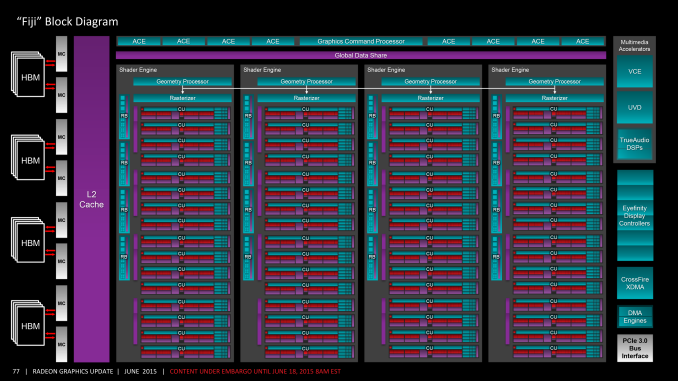
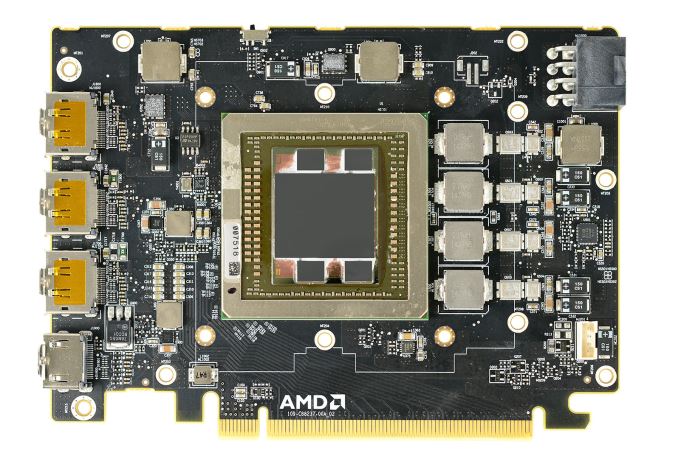



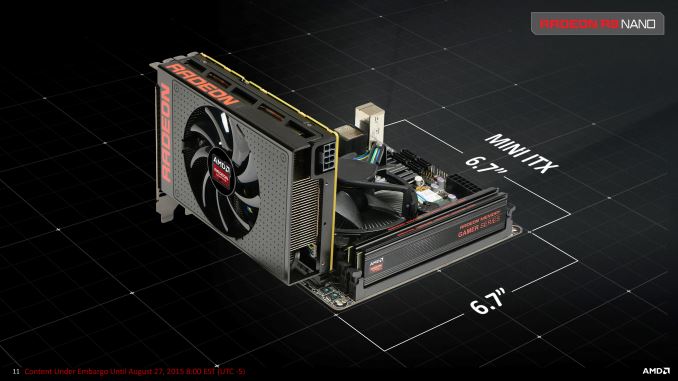
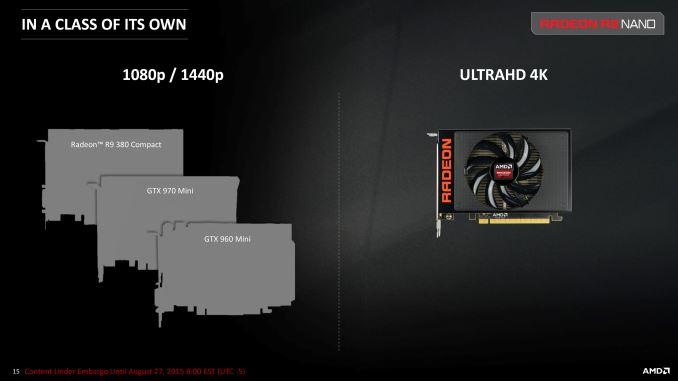
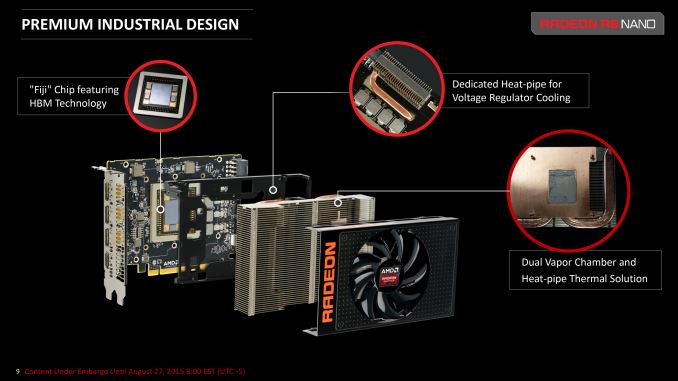














95 Comments
View All Comments
wintermute000 - Thursday, August 27, 2015 - link
according to doom9, HEVC main10 on the GTX960/950s is still hybrid and will struggle @ hi bitrates. I think I'll wait another generation before upgrading my HTPC - I'm not paying 200+ USD for a card that can't basically eat whatever video encode I throw @ it for breakfastKjella - Thursday, August 27, 2015 - link
More like no sale, no money product. How many gamers willing to splash $650 on a graphics card is going to let themselves be this crippled by case size? I thought the Nano was going to be their mainstream Fury card, I'm not so concerned about this card but that it probably means the Rebrandeons will be all AMD has for the <$500 market for quite a while. This can not end well.dagnamit - Thursday, August 27, 2015 - link
In the end, 20nm planar is what killed AMD. I'm certain both AMD and Nvidia have a gigantic backlog of designs just waiting for implementation when it's their turn at the 14-16nm trough. AMD still has a shot, but they need to kill it with the next generation.Ananke - Thursday, August 27, 2015 - link
NVidia has a 7 nm design since last year ready for production. 14 and 10 nm has been done long time ago.I like AMD, but at this price they will sell at most 500 units in all. I don't think AMD will be able to recapture even its R&D cost for the new Fury architecture, unless they manage to win in next generation consoles. By that time NVidia and many others will have HBM. NVidia will have it by Feb-March next year, as far as I know. Sad, but I think AMD are financially done - no aggressive pricing, no market share, no enough time for exclusivity.
silverblue - Thursday, August 27, 2015 - link
Fury will just end up in the next series as a slightly lower tier part I should imagine, unless it's AMD's Big Experiment which would naturally lead to HBM2 parts on 16nm next year with Fury on 28nm being a one-time thing.The price is high, but let's put this into some sort of perspective - it's meant to fill a niche which is limited by cooling and size, both of which the Nano should be able to overcome. Turning up to a LAN event with a machine that performs within a few percent of the larger single GPU machines at a much reduced size would be amusing. There are more than seven billion people on this planet, so I imagine more than a handful see this as a good idea. Also, remember for some people, money is no object - the exact reason people buy Titan graphics cards and hexa/octocore Intel CPUs when a 980Ti and 4790k will do. Small usually means a price premium anyway.
As far as I remember, AMD have first crack at HBM2, so I wouldn't expect NVIDIA to beat them to it.
testbug00 - Thursday, August 27, 2015 - link
How do they have a 7nm design when there are no design rules for ANY 7nm processes? You're full of it.Never mind that most 10nm process likely only finalized design rules under a year ago, at best.
piiman - Saturday, August 29, 2015 - link
"I like AMD, but at this price they will sell at most 500 units in all."LOL Want to bet?
meacupla - Thursday, August 27, 2015 - link
How about I want a gaming PC that isn't too heavy and fits in my luggage case?RVZ02/ML08, SG13, etc. that sort of deal.
PEJUman - Thursday, August 27, 2015 - link
This is similiar to titan X, how many gamer will pay extra 100 - 350 USD for additional 3% performance?I have a mini-ITX 970 in my secondary gaming machine, using xigmatek nebula case. This is the half show case, matching the design of my def tech studio monitor speakers. I am definitely in the market for this nano fury, just because it's the fastest small card. The same way titan x is the fastest flagship.
Neither nano nor titan are cost effective, but price/perf is not part of their marketing role.
limitedaccess - Thursday, August 27, 2015 - link
It would be interesting in the review if you attempt to replicate Fury Nano's power usage via clockspeed, voltage, and power limiter adjustments particularly with the Fury X. Possibly the reverse as well.